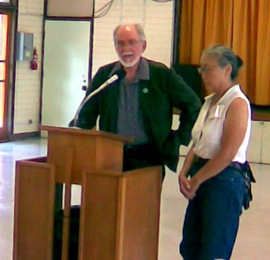September 24 Meeting: Pamela Cunningham--Medicare
What in the World is Going on with Medicare?
 Click
Click  here to listen.
here to listen.
Pamela Cunningham is coordinator of Sage PLUS, the free State Health Insurance Assistance Program in the Executive Office on Aging. For those who were unable to attend her presentation, you can learn about the newest complexities in Medicare in this audio recording. Just click on the link above to begin playing. Handouts can be downloaded by right-clicking here.
Medicare’s attempt to give choices to Social Security beneficiaries has resulted in an overwhelming 9 private insurance companies offering 16 various policies called Medicare Advantage Plans and 46 offering prescription drug plan options. Each one may have different benefits, co-pays and deductibles. Sage PLUS’ job is to help people narrow the choices to which one is best suited to their needs if they decide to change from original Medicare. If you wish to choose a new plan you can do so only once a year from November 15 – December 31; with the new plan starting January 1. Cunningham suggests considering the criteria below when considering a change. Sage Plus will also help you file an appeal if you are denied any benefits. Call 586-7299 for information and help and/or use www.medicare.gov “compare Health Plans.”
1. Will I gain any benefits from the new plan?
2. Is my current plan something that I can change? (If it is offered through a retirement package, you may have fewer options and need to check with the company’s plan administrator).
3. What will my out of pocket expenses be if I am in the hospital, my doctor visit, use ambulance service?
4. Do my doctors, hospitals and other providers understand and work with the new plan?
5. Do I pay more if I go to a doctor or facility outside the plans network? Does the plan have a network?
6. If the plan provides drug coverage—are the prescription drugs that I take covered by the plan? Does it work at my pharmacy choices?
 Click
Click Pamela Cunningham is coordinator of Sage PLUS, the free State Health Insurance Assistance Program in the Executive Office on Aging. For those who were unable to attend her presentation, you can learn about the newest complexities in Medicare in this audio recording. Just click on the link above to begin playing. Handouts can be downloaded by right-clicking here.
Medicare’s attempt to give choices to Social Security beneficiaries has resulted in an overwhelming 9 private insurance companies offering 16 various policies called Medicare Advantage Plans and 46 offering prescription drug plan options. Each one may have different benefits, co-pays and deductibles. Sage PLUS’ job is to help people narrow the choices to which one is best suited to their needs if they decide to change from original Medicare. If you wish to choose a new plan you can do so only once a year from November 15 – December 31; with the new plan starting January 1. Cunningham suggests considering the criteria below when considering a change. Sage Plus will also help you file an appeal if you are denied any benefits. Call 586-7299 for information and help and/or use www.medicare.gov “compare Health Plans.”
1. Will I gain any benefits from the new plan?
2. Is my current plan something that I can change? (If it is offered through a retirement package, you may have fewer options and need to check with the company’s plan administrator).
3. What will my out of pocket expenses be if I am in the hospital, my doctor visit, use ambulance service?
4. Do my doctors, hospitals and other providers understand and work with the new plan?
5. Do I pay more if I go to a doctor or facility outside the plans network? Does the plan have a network?
6. If the plan provides drug coverage—are the prescription drugs that I take covered by the plan? Does it work at my pharmacy choices?
 Kokua Council
Kokua Council
 Click
Click 
